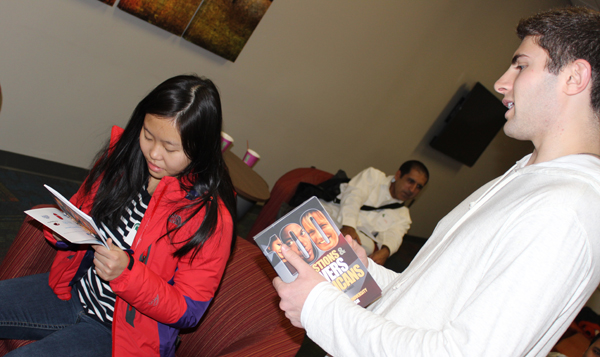How to talk to an American
Tell any American college student that you’re tailgating, hooking up or going on a pub crawl, and they’ll know you’re talking about partying before a sporting event, having casual sex and stopping at various bars to drink.
But the phrases often are a confusing mishmash to international students on U.S. campuses, who struggle to figure out not only American slang but behaviors some can find puzzling, such as challenging professors.
That confusion prompted a Michigan State University journalism class to ask MSU international students what questions they had about Americans. The result is a 50-page guidebook, “100 Questions & Answers about Americans,” that’s now available for just under $10 at Amazon and Barnes & Noble online.
“I didn’t know they didn’t understand us,” said Joe Grimm, the visiting editor in residence at the School of Journalism who led the one-credit class that produced the guidebook in 70 days. “It gives us a new picture of ourselves.”
It also gave the American and international students a chance to interact and find out more about each other. Journalism major Max Gun said the funniest question he heard was from a Chinese student who wanted to know why Americans obey traffic laws requiring them to stop at stop signs and red lights, because such laws are largely ignored in China.
“It took him a couple of weeks to get used to following the rules,” Gun said. “He told me he learned his lesson after getting three traffic tickets in his first week of driving in America.”
A record number of international students are attending U.S. colleges and universities, according to the Institute of International Education, with more than 800,000 in the 2012-13 academic year. MSU is the ninth most popular university in the nation among foreign students, with more than 6,700 from 131 nations, mostly from China. (The University of Michigan ranks eighth.) As a state, Michigan has 27,000 international university students, also ninth. Grimm thinks the guidebook can meet a huge need in Michigan and nationally.
Linh Dao, a freshman from Vietnam studying supply-chain management and packaging, got a copy from Gun last Friday at MSU’S Office of International Students and Scholars coffee hour.
“I’m involved in a student organization that tries to bring domestic and international students together, so I think the book is a very useful resource for international students to gain insights about life in the U.S.,” she said.
Gov. Rick Snyder is pushing for more international students to study and stay in Michigan. The Global Talent Retention Initiative, funded by the Michigan Economic Development Corporation and a grant from the New Economy Initiative of Michigan, is bringing together Michigan universities, economic development groups, ethnic chambers of commerce and professional organizations to help retain top international talent in the state by finding them jobs with Michigan companies.
While some of the questions in the guidebook involve serious topics such as why racism is such an issue in the U.S., why there are so many guns in the U.S. and how common divorce is in America, others are more lighthearted.
“Why are American men so tall?” is one question asked and answered in the book. “What does hand holding mean in America?” is another.
Then there are questions such as, “If marijuana is illegal, why do so many people smoke it?” and “Does dating mean having sex?” and a question about why Americans seem to constantly spend money or want to be entertained.
“They wonder why Americans say, 'How’s it going?’” Grimm said. “That came up a lot – and it came up from a lot of different students, too.”
The 16 students in Grimm’s “Bias Busters” journalism class interviewed about 50 international students from every continent except Antarctica. Not all of them saw Americans the same way. One woman from Saudi Arabia wanted to know why Americans work so hard, Grimm said, while a Chinese student wondered why Americans didn’t work harder.
Grimm plans to have another “Bias Busters” class begin work in a guidebook for Hispanic and Latino students in January, and also will reprint guides on Arab-Americans and Native Americans next semester. A class he taught last spring produced a guidebook to help Americans better understand students and immigrants from India. All are or will be available as paperbacks and e-books.
Gun said working on the book helped him better understand the international students on campus.
“This project made me realize the importance of making people feel comfortable in potentially uncomfortable situations -- such as moving to the United States and not knowing much about Americans,” the third-year student said. “Helping create this guide was a tremendous learning experience.”
Michigan Education Watch
Michigan Education Watch is made possible by generous financial support from:
Subscribe to Michigan Education Watch
See what new members are saying about why they donated to Bridge Michigan:
- “In order for this information to be accurate and unbiased it must be underwritten by its readers, not by special interests.” - Larry S.
- “Not many other media sources report on the topics Bridge does.” - Susan B.
- “Your journalism is outstanding and rare these days.” - Mark S.
If you want to ensure the future of nonpartisan, nonprofit Michigan journalism, please become a member today. You, too, will be asked why you donated and maybe we'll feature your quote next time!


 MSU journalism major Max Gun discusses "100 Questions & Answers About Americans," a new book on U.S. culture and slang with Linh Dao, a freshman from Vietnam. (Courtesy photo)
MSU journalism major Max Gun discusses "100 Questions & Answers About Americans," a new book on U.S. culture and slang with Linh Dao, a freshman from Vietnam. (Courtesy photo)
